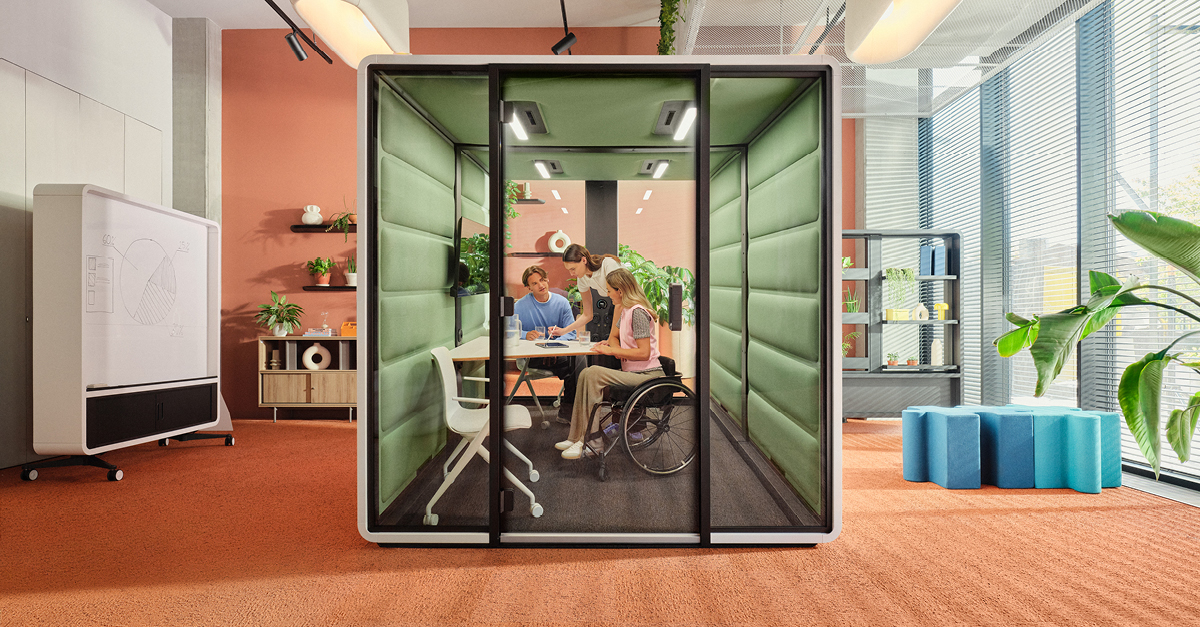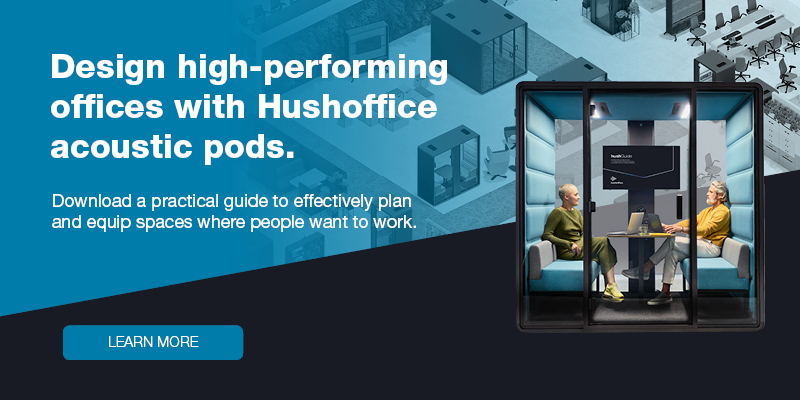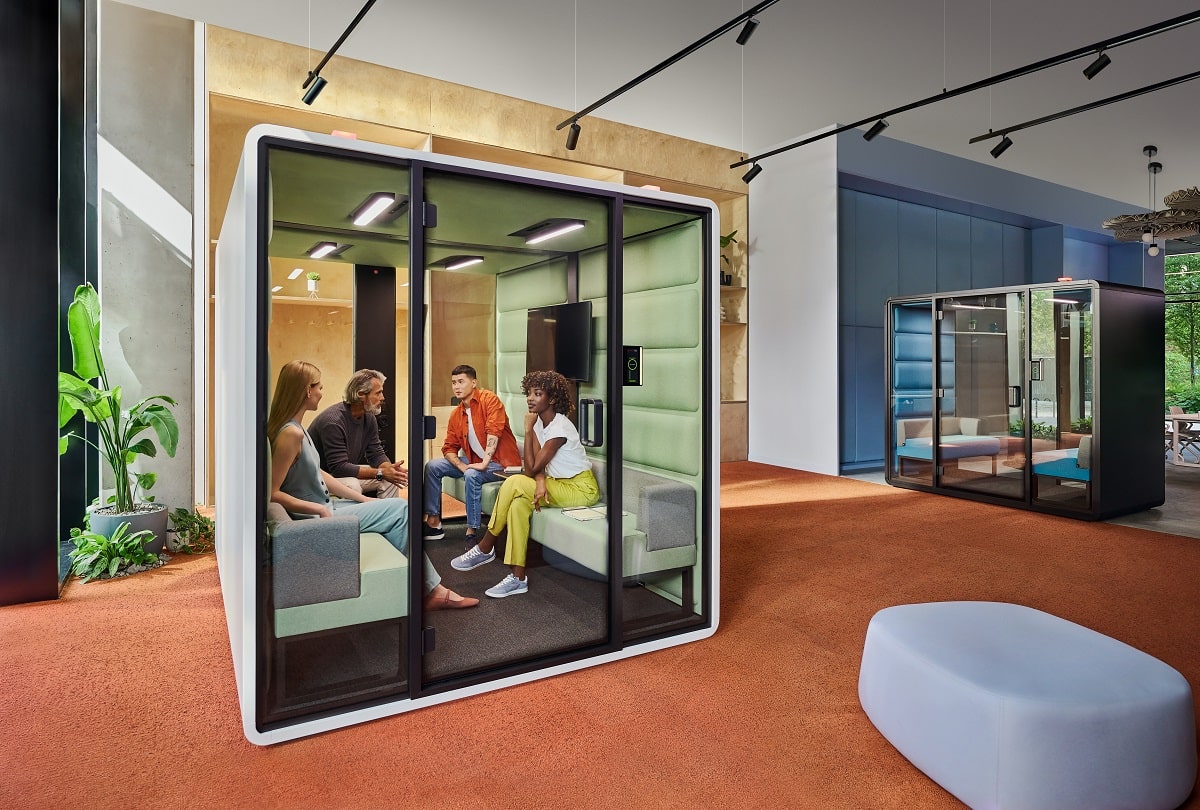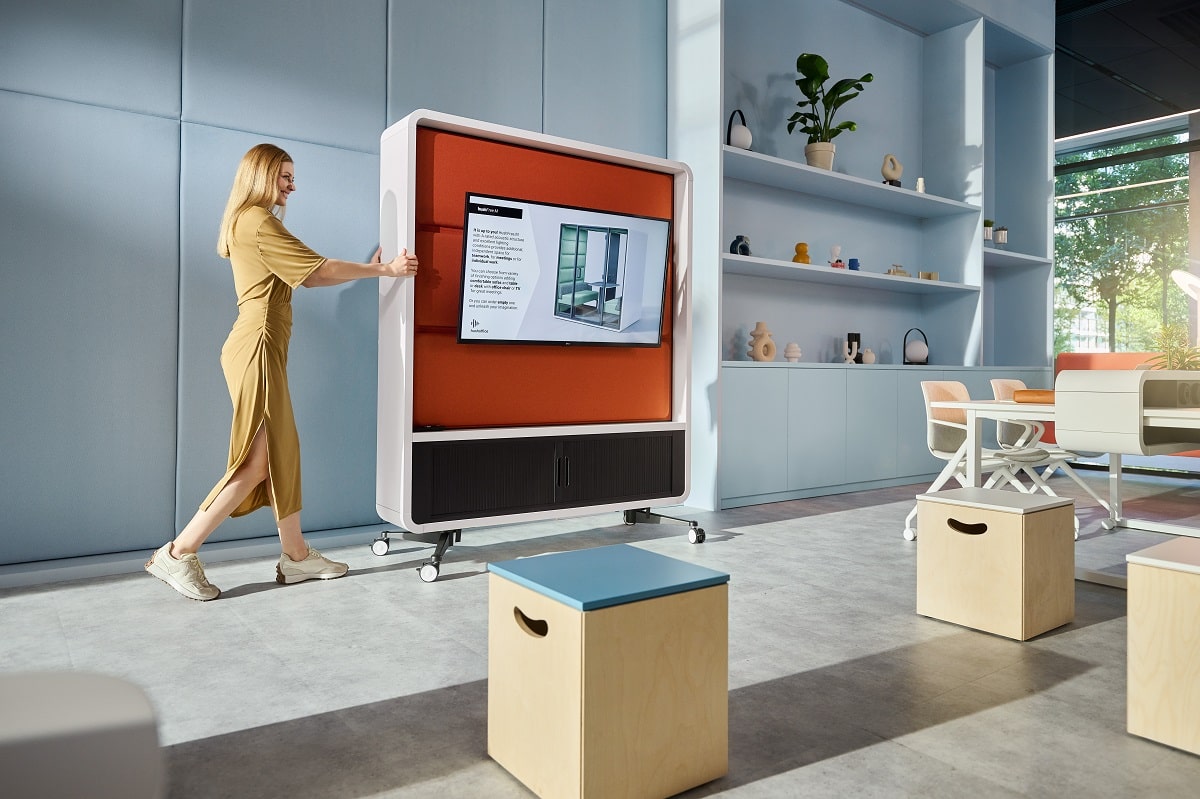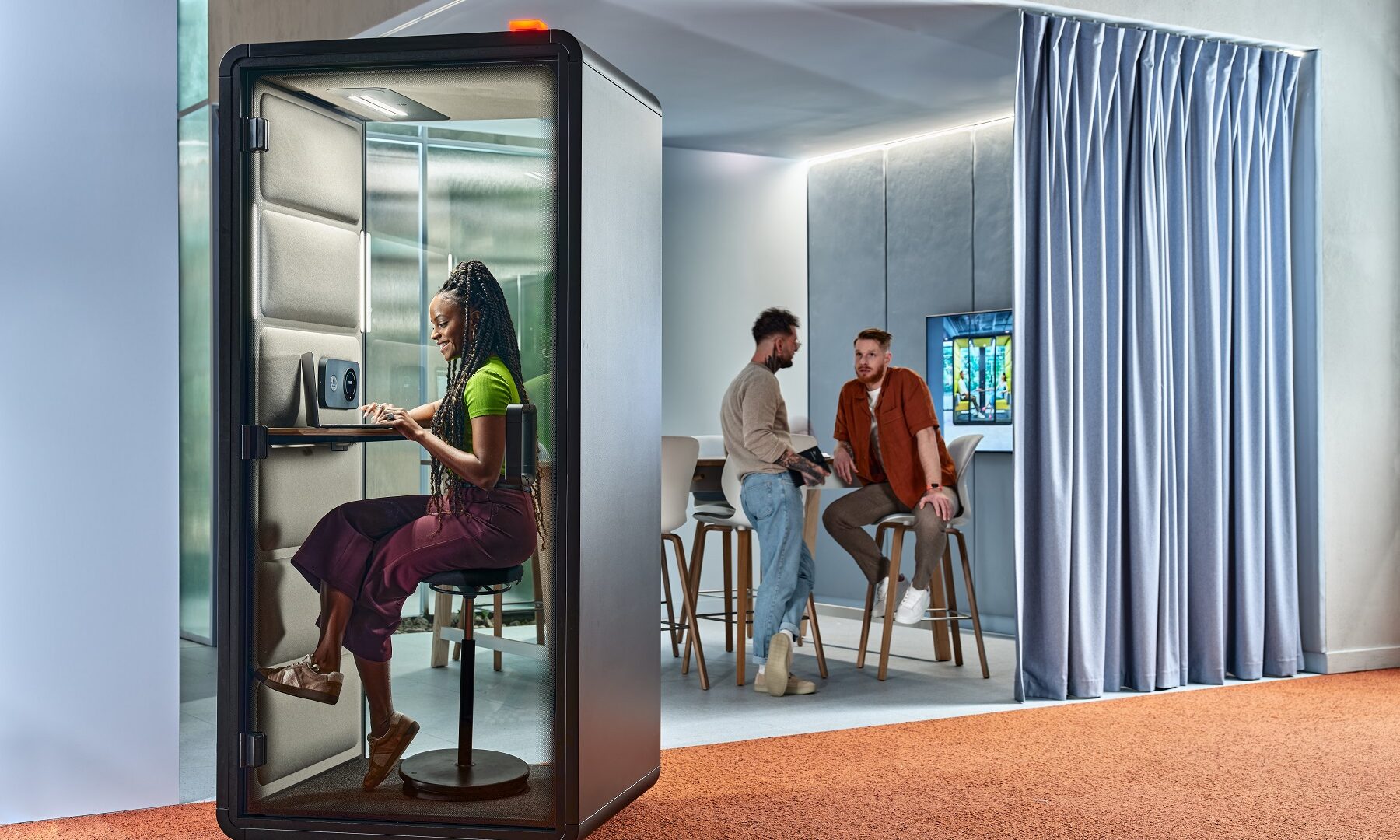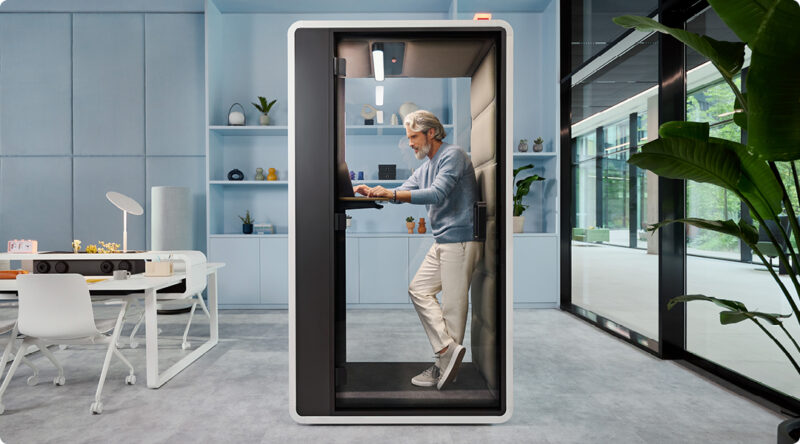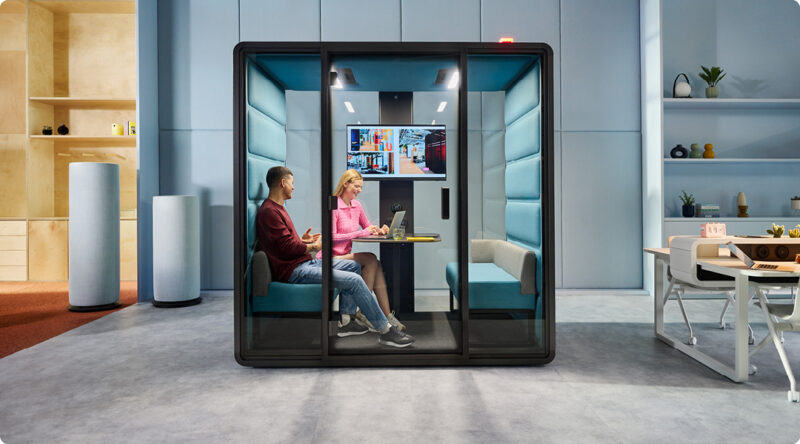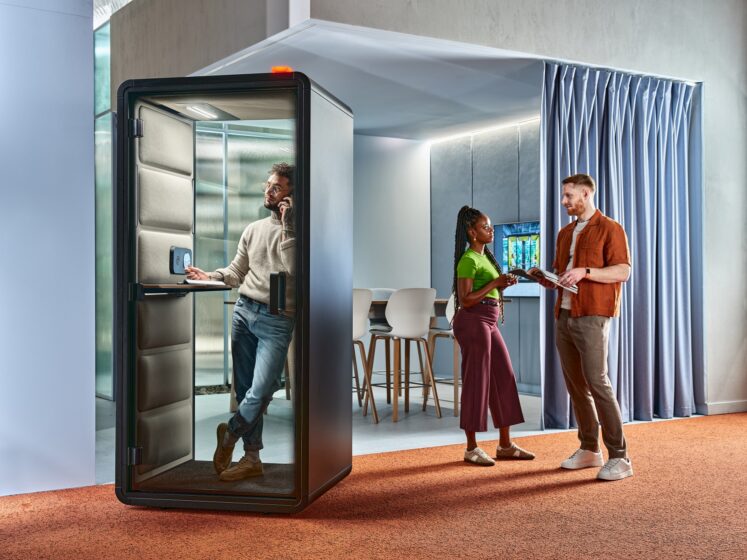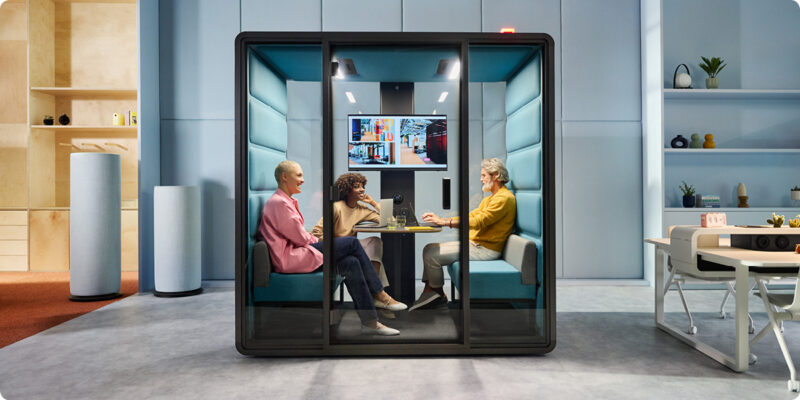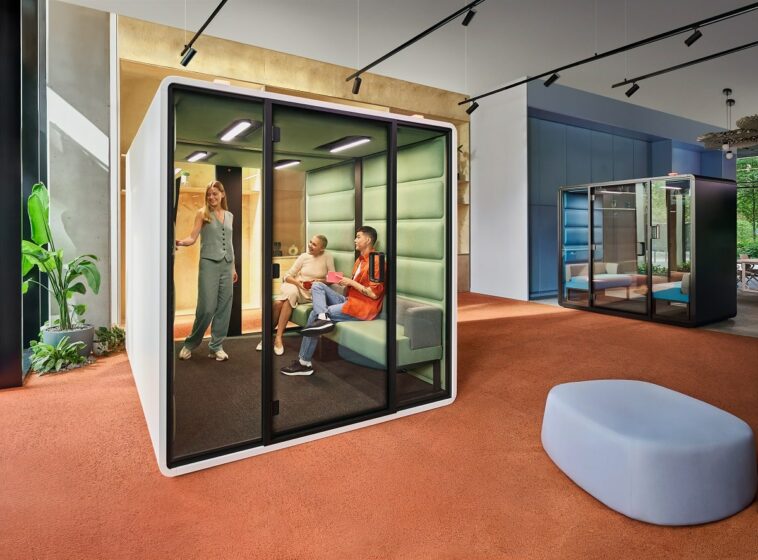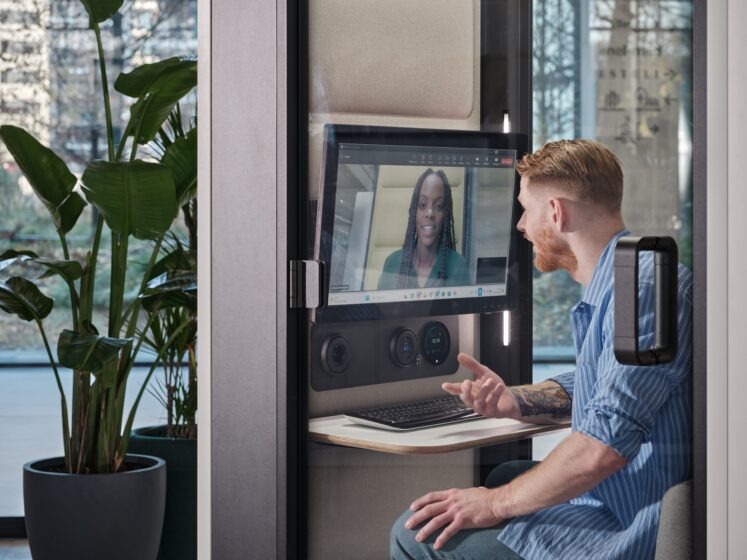Designing the office as a catalyst for creativity
- Posted on: 13 June 2025
- By: Hushoffice Team
Bright ideas rarely arrive on demand. They tend to emerge when mood, mindset, and space are aligned. That’s precisely why the layout and feel of the workplace can either nurture or hinder inventive thinking. Here’s how office design can lay the groundwork for deep thought and effortless collaboration.
Office design for creativity – tl;dr
- Creative thinking thrives on contrast. While energising spaces can prompt idea generation, it’s the calm, secluded settings that allow those thoughts to take shape. A workspace that combines both, featuring acoustic booths, supports the entire creative arc, from spark through development to execution. Without this balance, teams often hover in a noisy blur of beginnings or get stuck in uninspired silence.
- Visually rich, adaptable environments that engage the DMN (default mode network) of the brain, an essential component in creative cognition. However, an absence of psychological comfort or overstimulation can deactivate it just as quickly. This makes variation and autonomy over space essential, not optional. Features like hushFree booths, textural contrast, and movable walls provide the right amount of intrigue without overwhelming, striking a balance ideal for solving problems imaginatively.
- What gives hushFree booths their real edge isn’t just portability—it’s the steady base they offer. Comfortable, sound-protected, and inviting, they make focused solo work and spontaneous idea-storming equally possible, creating a space where creative thinking can truly flourish.
Why do cafés sometimes spark better ideas than conference rooms?
Conference rooms provide structure—professionalism, tools, and clarity. But they can also feel rigid, which restricts expansive thought. Cafés, in contrast, invite creativity through a more relaxed feel—the background murmur and varied visuals foster a mental openness. The downside? Constant interruptions and zero privacy. That’s where solutions like hushFree shine. They bring the professionalism of a meeting room with a more relaxed, approachable feel
– explains Hushoffice Principal Brand Manager, Mateusz Barczyk.
Traditional layouts can stifle creativity.
Environments that stimulate the default mode network in the brain help with creative leaps. But excessive stimulation becomes overwhelming. Designing spaces that are inspiring yet calm enough to maintain focus–that’s the challenge. This is where curated interiors come into play.
Open plans: teamwork paradise or concentration nightmare?
While open offices encourage spontaneous exchanges, they often compromise concentration with visual and acoustic disturbances. Employees may interact more, but this comes at the cost of producing deeper, well-formed ideas. Here, private zones are indispensable.
Monotony: the silent killer of creativity.
The mind craves visual stimulation—dynamic architecture, mixed materials, playful patterns, bold colours. Introducing modular elements, such as a strategically positioned hushFree.L booth, can disrupt dullness and prompt mental exploration.
Privacy matters — creative freedom under pressure?
Taking creative risks requires a foundation of psychological safety. Without privacy, people self-censor. Dedicated quiet spaces give a silent cue: here, it’s safe to voice ideas in early, imperfect stages. Their absence can leave minds constrained. Spaces to be alone communicate that it is fine to explore unusual or half-formed ideas, without judgment.
Building for innovation means building in tune with mental cycles.
Creative work needs contrast, adaptability, and emotional responsiveness. Offices should act as ecosystems that nourish insight not only during offsite retreats but built into the architecture and the everyday rhythm of work life.
Stimulating surroundings help refresh mental processes through novelty and variation. But idea generation is just one phase. Refining those ideas demands peace and focus. That’s where booths like hushFree come in— they offer a serene, sound-insulated space to step away and hone thoughts in quiet. And for moments where only partial seclusion is needed, a flexible unit like hushWall provides just the right touch of separation. It all comes down to giving people options
– says Hushoffice Principal Brand Manager, Mateusz Barczyk.
Adaptable work zones mean better thinking.
Conceptual thinking ebbs and flows. That’s why flexible furnishings and mobile layouts are invaluable. When employees can adjust a workspace to suit their cognitive needs, creativity often sees a measurable boost.
Harnessing nature, lighting and colour to support creativity
Earth-toned palettes, greenery, and sunlight aren’t just pleasant touches—they’re mental stimulants. Natural light lowers stress hormones, plants aid lateral thinking, and even wooden textures can enhance creative performance.
Balancing collaboration with solitude.
Creativity demands both synergy and solitude. Offices today must provide open, shared settings as well as calm corners. A hushFree.M booth for four tucked just beyond the main workstations can be the perfect place to reflect and shape ideas before presenting them to others.
Acoustic pods help eliminate disruption for deeper thinking.
Interruptions derail inventive thought. Pods like hushFree offer the sensory isolation needed for concentration. Inside, the calm gives thoughts room to connect and take clearer shape.
A dedicated space for lateral thinking…
The best ideas often surface in liminal states—half-focused, half-relaxed. Booths like hushFree.S recreate that space, offering adjustable lighting, acoustic separation, and a gentle sense of enclosure, not unlike the creative calm of studios or libraries.
Privacy unlocks daring thought…
When people feel observed or judged, they begin to self-edit. This blocks unconventional ideas. A fully enclosed, Class A booth like the hushFree.L creates the psychological freedom needed to express raw thoughts or risky hunches—the kind of ideas that may seem far-fetched at first but often turn out to be brilliant breakthroughs.
A haven for individual deep work…
Imaginative leaps often occur in solitude, where unrelated concepts merge in unexpected ways. But such cognitive wandering demands stillness. The hushFree.XS one-person standing pod offers exactly that: a quiet, upright workspace tailored for mental immersion and intuitive exploration.
Booths support team ideation from start to finish.
Work pods like hushFree are not just for solo tasks. They play a vital role in every creative stage a group encounters—brainstorming, evaluating, iterating, and delivering.
Ideation. Generation and selection of ideas in a hushFree.M without limits.
Quantity over quality is the mantra when generating ideas. Judgment is for later. In smaller, relaxed settings like the hushFree.M four-person booth, people feel freer to speak openly. Equipped with adjustable airflow and power access, it keeps energy levels up and ideas flowing.
Conceptual work in private. HushFree.XS for focused time alone.
Creative teamwork requires rhythm. After the noisy storm of idea generation comes a quieter phase—where thoughts are refined. A compact, enclosed pod such as hushFree.XS, outfitted with hushAssistant and positioned near collaboration zones, gives teams a retreat space for this shift between collective and individual effort.
A space for private meetings and sensitive discussions.
Innovative ideas often carry commercial weight. They must be shared in settings that protect both the message and the messenger. HushFree booths provide this security — acoustically sound, visually discreet, and equipped for professional exchanges.
HushFree.L. The professional’s refuge.
Whether hosting a one-to-one or rehearsing a pitch, space matters. The hushFree.L model offers controllable lighting, steady ventilation, and Class A soundproofing, ensuring both comfort and discretion. Its accessible counterpart, hushFree.Access.L, accommodates wheelchair users with ease.
What beyond space design can help creativity flourish at work?
Creativity grows from autonomy and a sense of psychological safety. Companies that are successful give employees permission to step away from strict schedules, encouraging curiosity-led side ventures and reflective downtime — spaces where minds can roam freely.
Neuroscience has shown that the brain often forms its most original connections during moments of pause—transitions, daydreams, or even aimless wandering. These interludes let seemingly random thoughts collide and reshape into novel ideas. But these mental gaps need permission and the right setting. HushFree booths create such spaces. They act as a physical signal that thinking time matters. In essence, they tell the occupant: this space is yours, you’re not on display, and creative thinking is welcome here
– explains Hushoffice Principal Brand Manager, Mateusz Barczyk.
Office design for creativity – tl;dr
- Creative thinking thrives on contrast. While energising spaces can prompt idea generation, it’s the calm, secluded settings that allow those thoughts to take shape. A workspace that combines both, featuring acoustic booths, supports the entire creative arc, from spark through development to execution. Without this balance, teams often hover in a noisy blur of beginnings or get stuck in uninspired silence.
- Visually rich, adaptable environments that engage the DMN (default mode network) of the brain, an essential component in creative cognition. However, an absence of psychological comfort or overstimulation can deactivate it just as quickly. This makes variation and autonomy over space essential, not optional. Features like hushFree booths, textural contrast, and movable walls provide the right amount of intrigue without overwhelming, striking a balance ideal for solving problems imaginatively.
- What gives hushFree booths their real edge isn’t just portability—it’s the steady base they offer. Comfortable, sound-protected, and inviting, they make focused solo work and spontaneous idea-storming equally possible, creating a space where creative thinking can truly flourish.
Hushoffice FAQ
How does our brain react to different office settings while forming ideas?
The DMN (default mode network) in the brain—active during internal reflection and imagination—responds best to calm, slightly varied environments. Natural textures, greenery, gentle visual interest, and acoustic stability engage this system. In contrast, spaces that are chaotic or dull can suppress it. The most supportive workspaces hit a balance: enough stimulation to engage, enough quiet to focus.
Which design components have been proven to enhance creativity at work?
Natural features (wood, plants, daylight), flexible furniture layouts, warm colour tones (in colour theory, these support original thinking), and designated areas of quiet spaces (for immersion) and open spaces (for energy) all help. These elements not only promote curiosity and open thinking but also reinforce a sense of mental safety, which is essential for creative risk-taking.
What makes acoustic pods like hushFree so essential in creative workplaces?
Today’s offices face a paradox—fostering collaboration while also protecting concentration. Open plans foster connection but also generate noise and distraction. Acoustic booths act as micro-environments of stillness. They’re agile tools that support solo focus, sensitive chats, and impromptu group brainstorms—meeting creative needs as they arise. That’s why they’re a key part of any innovation-friendly office strategy.
